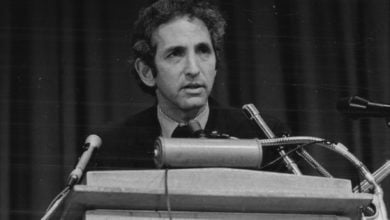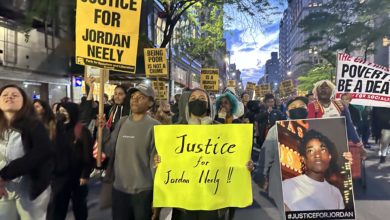 Harry Haywood, Black communist leader |
In commemoration of Black History Month, we are re-posting this article.
There is an old saying that “history is written by the victors.” While subject to some caveat, in the history of Black Americans it has held very true. Many books have been written about Black leaders and activists, who were vilified or under assault during their day, but have since been converted into harmless icons.
Lenin could have been talking about the U.S. media’s presentation of Black History Month when he wrote, “attempts are made to convert [great revolutionaries] into harmless icons, to canonize them, so to say, and to surround their names with a certain halo for the “consolation” of the oppressed classes and with the object of duping the latter, while at the same time emasculating the essence of the revolutionary teaching, blunting its revolutionary edge and vulgarizing it.”
This is particularly true of Black historical figures whose ideology was vague enough to be manipulated into a pro-capitalist or patriotic perspective. According to this narrative, U.S. capitalism is fully able to resolve the country’s “racial” problems, and each of these Black leaders merely functioned to improve capitalism’s faults.
But for every Black leader who has been canonized, there is another who is faded into the background, relegated to footnotes, and passing mentions in mainstream history. This is particularly true of Black communists, whose firm commitment to the overthrow of capitalism makes them untouchable and virtually unmentionable.
Harry Haywood, a prominent communist leader of the 20th century, fits squarely into the latter category. Haywood was a long time member and leader of the Communist Party-USA and other communist organizations from the 1920’s until his death in 1985. He was the key figure in developing and popularizing the concept that Blacks represented a separate “nation” inside the United States. For more information on Haywood’s theoretical and political contributions, click this link.
While Haywood merits almost no mention in many accounts of Black history, his theoretical innovations probably did more than any other one individual to frame the terms of the debate about the historical character of the “Black community.”
Early life
Haywood was born in 1898 in what is now Omaha, Nebraska, to a family of self-educated ex-slaves. Forced out of Omaha by racist violence, Haywood’s family settled in Minneapolis, where he lived during his adolescence. Faced with rampant prejudice in Minneapolis schools, Haywood ended his formal education in the 8th grade and went to work full time, taking on a variety of occupations.
Haywood moved to Chicago in 1915, where he soon ended up in the National Guard, caught up in the war mobilization for WWI. He suffered all the indignities and injustices of the Black soldiers of his time, serving in segregated units, and training in the citadel of reaction, the Deep South.
Even while deployed in France, Haywood’s regiment could not escape Jim Crow’s long shadow. The racist military establishment attempted to infect the French people with prejudice and refused to allow any Black officers to command the segregated troops. These efforts to reproduce U.S. racism in France largely failed, and Haywood, like many other soldiers in both World Wars, drank deeply that most powerful of intoxicants: “freedom.”
 The racist mob violence that broke out in Chicago in 1919 was a formative event in Haywood’s life. |
Upon returning to the United States, Haywood walked directly into the 1919 Chicago Race Riot. Throughout 1919 race riots raged across the United States, with that summer being known as “Red Summer,” because of the blood that was spilled by racist mobs. That was not the only blood that was spilled however, and in cities and towns across the country, Black communities—spearheaded by war veterans—organized to defend their neighborhoods.
Harry Haywood joined other Black veterans in Chicago, who mounted a Browning sub-machine gun in an apartment window and stood guard with Springfield rifles. Haywood mentions this moment in his autobiography as the most important turning point of his life. Fed up with the endless racism in U.S. society—and believing firmly that a better world was possible—Haywood committed himself from then on “to struggle against whatever it was that made racism possible.”
Becoming a leading communist
Haywood came into contact with a number of radical groups of the period, briefly becoming a member of the African Blood Brotherhood, led by Black communists, before joining the communist party itself in the mid 1920s. A few years later the Party chose Haywood for further studies at the Communist International schools in Russia.
It was in the Soviet Union that Haywood began to emerge as one of history’s most prominent Black communists. As a body dedicated to stimulating and coordinating worldwide revolution, the Comintern emphasized the working class’s unity with the world’s colonized and nationally oppressed peoples. As such, the Comintern leadership was sharply critical of the CPUSA’s almost non-existent work amongst African Americans. While a few Black activists had joined primarily because of their attraction to the Russian Revolution, mass work amongst Blacks was lagging.
Haywood did not attribute this problem primarily to lack of effort, nor simply white chauvinism (although this was a considerable problem among some members). Rather, he recognized that the Party had not undertaken any systematic analysis of the history and state of oppression facing African Americans. Without a theoretical framework to anchor and guide their work, the young Communist Party was basically fumbling around.
It was here, working on various Comintern commissions that Haywood became the key figure in elucidating what became known, perhaps somewhat erroneously, as the “Black Belt Thesis.” He also was involved in discussions around the question of race and nationality in South Africa.
Haywood returned to the United States in the early 1930’s and continued to play a leading role in formulating the theoretical positions of the Communist Party on the “Negro question.” He served for a time as the head of the League of Struggle for Negro Rights, a party sponsored mass-organization set up to fight white supremacy. Haywood also served as an organizer in the 1931 miners’ strike in West Virginia, building unity between Black and white workers. He was involved in defense of the framed up Scottsboro Boys, who were sentenced to death by Jim Crow courts in Alabama, but set free due to mass struggle on the part of the Black and white working population.
In 1938, Haywood also served in the Spanish Civil War along with other left-wing volunteers who went to join the fight against fascism. Personal confrontations with local commanders led him to return to the United States after only six months—and were then used to demote him from the CPUSA’s top leadership.
Haywood’s marginalization, but lasting legacy
During the late 1930s, the CPUSA moved away from the theoretical conceptions put forward by Haywood, and began to liquidate a number of the more successful campaigns amongst Blacks. The Party’s embrace of Popular Front politics required that they ingratiate themselves more fully with liberaland centrist political organizations. In the North, this led them to accept the reformist leadership of the NAACP. In the Party’s southern work, an accommodation with liberalism required a downgrading of the militant, communist-led sharecroppers’ movement.
The Party by no means abandoned the struggle against racism, and they continued to recruit large numbers of African Americans. But those like Harry Haywood—who advocated a united front against racism that would allow the Communists to challenge bourgeois leadership—were forced to the sidelines.
As the Cold War began to take shape after WWII, the CPUSA reoriented again towards sharper confrontation with the capitalist class. In this context, Haywood was able to revive his landmark theory in the 1948 book “Negro Liberation,” written with the financial help of Paul Robeson. This, however, was a short-lived renaissance; as the Party fell victim to the anti-communist witch-hunt, it again oriented towards liberalism, seeking refuge in unwelcoming organizations like the NAACP. Harry Haywood was increasingly shunned and his revolutionary analysis of the “Negro question” was replaced with a theoretical conception that had more in common with bourgeois liberal currents of the period. In 1959, Haywood was expelled.
Throughout the 1960s and 1970s, Harry Haywood continued to defend his “Black Belt Thesis,” which became influential again in the radical resurgence. As a new generation of activists in the Black liberation movement and the Left studied and debated the African American national question and the concept of “internal colonies,” the work of Harry Haywood framed the debate and remained a vital starting point.






